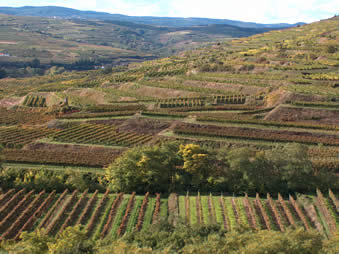|
Austrian
wines
Part
1: Introduction
 The
subject of this new series on wineanorak, Austria is rapidly
becoming one of my favourite wine countries. It’s only recently,
however, that Austrian wines have come on to the radar screens of
wine geeks in the UK and USA. The
subject of this new series on wineanorak, Austria is rapidly
becoming one of my favourite wine countries. It’s only recently,
however, that Austrian wines have come on to the radar screens of
wine geeks in the UK and USA.
Most ‘average’ consumers don’t realise this,
but Austria makes brilliant, world class dry white wines from
Riesling and Grüner Veltliner, although this message has now
definitely filtered through to wine geeks across the globe. The
reason Austrian wines have not been better known abroad is
probably because the domestic market greedily snaps up most of the
good stuff, and this demand keeps the prices high.
Indeed, Austria doesn’t actually make that much
wine. But the word is out: the best Austrian whites are a match
for any, and increasing numbers of wine buffs are switching on to
them both in the USA and UK.
 In
particular, Grüner Veltliner (left) is gaining more of the
attention that it deserves. It’s Austria’s most abundant grape
variety, some 10 times more widely planted than Riesling, and
makes versatile, expressive white wines often with a distinct
peppery character. The new Chardonnay? That might be stretching
things a bit, but with its food friendliness and capacity to gain
complexity with age, Grüner looks set to gain more friends across
the globe. In
particular, Grüner Veltliner (left) is gaining more of the
attention that it deserves. It’s Austria’s most abundant grape
variety, some 10 times more widely planted than Riesling, and
makes versatile, expressive white wines often with a distinct
peppery character. The new Chardonnay? That might be stretching
things a bit, but with its food friendliness and capacity to gain
complexity with age, Grüner looks set to gain more friends across
the globe.
But it would be unfair to think of Austria just in
terms of Grüner Veltliner and Riesling from the Wachau, Kremstal
and Kamptal. It’s a country with a range of different climates
and vineyard regions producing a diversity of wine styles,
including some great sweet wines and even some serious reds.
It’s the whites get most of the attention, but the
reds have quietly been improving. Where they aren’t overoaked or
forced, they can be surprisingly good, although they are still
quite rare in the UK. Prices for Austrian wines remain a stumbling
block, keeping them a niche item in the UK trade. While they are
still pretty reasonable considering the quality, there’s not
much choice under a tenner, and you probably need to be thinking
about spending around double that to experience some of the very
best.
I visited Austria in early October 2004, where
harvest was just beginning in most regions. Over the next few
weeks I’ll be adding my impressions, together with some further
producer previews stemming from an Austrian wine dinner and the
Austrian trade fair held in London.
Grapes,
regions and vintages: an introduction
Grüner Veltliner
Austria’s own variety, which is capable of making complex,
full flavoured, spicy whites often with a distinctive white flower
and cracked pepper edge to them. While Austrian Riesling has
tended to steal the limelight, Grüner has just as much to offer,
and the good news is that there’s a lot more of it. It’s a
wine that drinks well young, yet can age, and it’s marvellously
food friendly. Worth discovering.
Riesling
In Austria Riesling performs very well, making usually dry
wines that have more precision than their Alsace counterparts and
more weight than those from Germany’s Mosel. Justifiably highly
regarded, but with plantings amounting to only 3% of Austria’s
vineyard area, there isn’t that much of it.
Weissburgunder
This is what Austrians call Pinot Blanc, and it makes lovely
gently aromatic dry white wines in southern regions such as Südsteiermark.
Welschriesling
Austria’s second most planted white grape and not related to
the true Riesling. Fresh, simple fruity dry whites are the norm,
but it can make sensational sweet wines.
 Zwiegelt Zwiegelt
The most abundant red grape; makes good wines ranging from
simple cherry fruit gluggers to more substantial reds destined for
ageing.
Blaufränkisch (right)
Common in Burgenland this makes spicy, sturdy, berry fruited
reds which can have some tannic structure. It’s the same grape
as Hungary’s Kefrancos.
Blauer Portugieser
This red grape makes soft, approachable, juicy wines mainly
for early consumption.
Regions
Wachau-Kremstal-Kamptal
These three neighbouring regions in lower Austria are the best
for Grüner Veltliner and Riesling. Most of the country’s
leading dry whites come from here.
Burgenland
On the Hungarian border, famous for its sensational sweet
wines from the Neusiedlersee, and increasingly good reds.
Südsteiermark
A southern region neighbouring Slovenia. Best for aromatic,
savoury white wines from Weissburgunder, Morillon (Chardonnay) and
Sauvignon Blanc.
Vintages
2004 A vintage that the Austrian wine-buying
public will appreciate: the long, cool, drawn out summer led to
light, crisp whites, and that’s how they like them. Not great,
but not bad either..
2003 Four atypically hot summer months led to
some brilliant red wines. The jury is out on whether this warm
year will also be a stunner for the whites. A disaster for the
botrytised sweet wines from Burgenland.
2002 With the widespread flooding in the key
regions during August, you’d be forgiven for thinking this would
be a washout. But growers are actually quite happy with quality
and rate this as a good year. Great for botrytis in Burgenland.
2001 September rains were the problem, but
overall a fairly good year for whites.
2000 This hot, dry vintage was a successful
one almost everywhere
1999 Superb for whites, reds and sweet wines
The
series
Wines tasted 10/04
Back
to top
|

